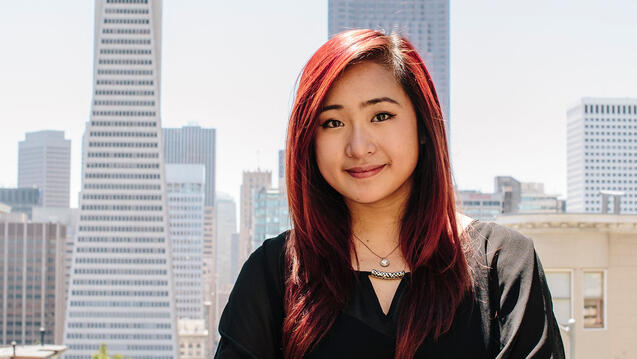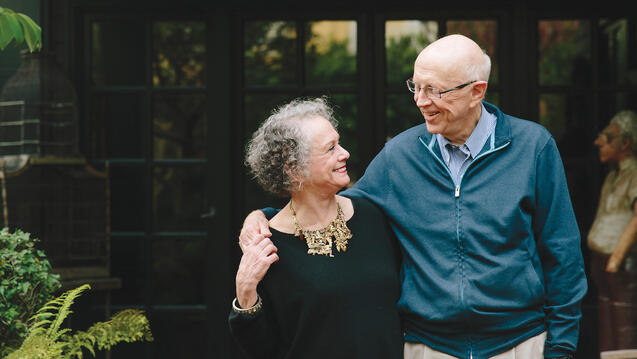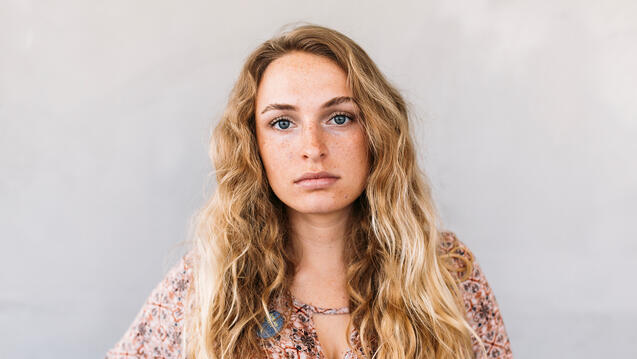From USF with Love
Fifty years ago, San Francisco took center stage in the national spotlight, as the city became a locus of anti-war protests, civil rights battles, and the sexual revolution.
The city drew a young generation full of big ideas and hope for a better future. Nearly 100,000 people converged on Haight-Ashbury neighborhood for what came to be called the Summer of Love.
They traveled from Seattle, Sag Harbor, and Kissimmee. These “hippies” — a term coined by San Francisco Chronicle columnist Herb Caen after he visited a “hip” new shop in Haight-Ashbury — embraced counter culture ideas and became a mainstay of the national media as America grappled with the changing times.
“Yet California was a state divided,” says USF history Professor James Zarsadiaz. “While the San Francisco Bay Area was a hotbed of revolutionary thought and action, the state consistently voted Republican in national elections.”
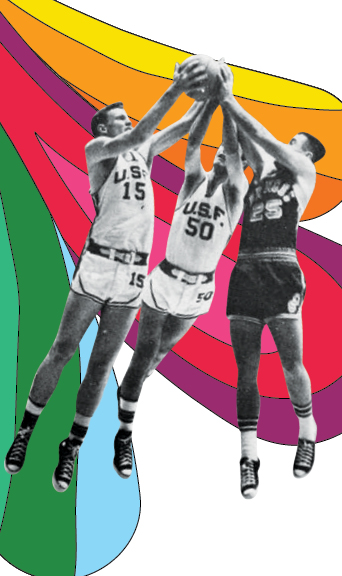
USF embodied that dichotomy. Located just blocks from Haight-Ashbury, it was a relatively conservative campus in the 1960s thanks to its Jesuit Catholic roots and its role since the 1930s as an Army ROTC host, which required male students to take part for two years. Many students chose USF to avoid the disruptive and sometimes violent protests happening at UC Berkeley and San Francisco State. And some came to USF on the G.I. Bill, returning from Vietnam.
But beginning with the introduction of female undergraduates in the College of Arts and Sciences in 1964, the times started to change at USF. Some students peacefully protested with campus sit-ins and mingled in the Haight-Ashbury wearing bellbottoms. A few started a folk rock band that released a hit song, “You Were On My Mind.”
By 1968, ROTC was voluntary, the number of required theology/philosophy units was cut, and the Black Student Union was founded. In 1978, USF bought Lone Mountain College and the two colleges merged, dramatically expanding the university’s size and boosting female enrollment.
Today, USF champions social and economic justice, civil rights and liberties, inclusion, and respect for all forms of identities and experiences — fairly radical ideas in the 1960s — as part of the university’s values.
“We can see a lot of parallels between what happened starting around the Summer of Love 50 years ago and today,” Zarsadiaz says.
So how did students from USF — then situated on today’s lower campus — and its sister school, the San Francisco College for Women (later called Lone Mountain College), experience the era? Here, in their own words, Dons recount their college years and the Summer of Love.
What happens in the Haight
Baring necessities
Vida Holguin, sociology ’71
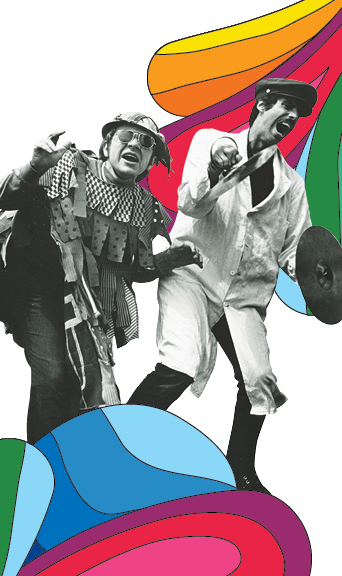
I had quite an introduction when I started at USF that Summer of Love. After my parents dropped me off at Gillson Hall, a bunch of fellow freshmen and I walked to Haight-Ashbury. The sun was shining, the smell of incense was in the air, there was tie-dye and smiles.
Then I realized my new friends were gone, and I was alone. I looked around and spotted them across the street. They were calling my name and waving me over. They pointed in front of me. I looked ahead and saw two longhaired men walking toward me wearing flowers in their hair. Then I realized the only thing they were wearing were those flowers. I had never seen a naked man in my life. They smiled at me, so I smiled back. As they passed, I thought, “I think I’m going to love it here.”
Spare change?
Dennis DeMattia, chemistry ’66, MS ’69
When I started in 1962, my parents would send me $10 a month. I would go to the Bank of America on Haight Street to cash the check. A year later, I started seeing “funny” people hanging around. One day, a young lady asked for spare change. I immediately started using the Bank of America on Geary Street and never went back. It wasn’t until the ’70s when PBS ran a retrospective on the ’60s that I found out what was going on. I still tell people today that I went to school just a few blocks from the corner of Haight-Ashbury but never knew what was happening there.
Bank lines and traffic jams
Denis Binder, economics ’67, JD ’70
Haight Street was jammed with cars barely crawling along in the worst traffic jams. The sidewalks were just as crowded. The bank lines were a block long on Mondays and Fridays, as the children of love cashed their checks from home. USF, five blocks from the famous corner of Haight-Ashbury, was an oasis of calm.
Poster child
Larry Blum, business ’67
USF had a really good basketball team in the early ’60s. In 1964–65 we were ranked third in the country.I played point guard, and we lost to UCLA by nine in the West Region. I broke Bill Russell’s freshman scoring record by one point.
Professor Jerry Gantz introduced me to Jerry Berman, who’d started a poster company with his friend Jack Kaus. They asked me to sell and distribute their posters. The first poster designed by Jerry, who was a great graphic designer, was the Haight-Ash bury street sign surrounded by daisies. I think we sold close to 150,000 copies. I sold them on Haight Street, then around San Francisco, and eventually around the country. Later, I bought the company and turned it into my own apparel and merchandising firm, working with brands like Star Wars and the NBA.
best of both worlds
Philip Carter, political science ’71, JD ’75
The dorms had some silly rules that weren’t working for me. So I moved off campus to Page and Cole streets and thought, “This is great. Now I’m living in the Haight and going to USF — it’s the best of both worlds.”
USF had an experimental college at the time. Students, faculty, and others could teach a class on any topic. I signed up to teach a class in my apartment on macrobiotic cooking. It was standing room only. How do you make brown rice? Nobody knew this stuff, but as a latchkey kid, I did. It was great fun.
Heard about the hippies
Michael Borelli, political science ’67
I heard about the hippies and had to check them out. I saw a side of life that I and most of my USF friends never knew existed. I had some great times, smoking my first joint, listening to music, and talking to new and “different” people.
From runny noses to overdoses
Elizabeth Principi, nursing ’70
I was an 18-year-old nursing student that summer, kind of restrained.
The Haight was a calm, gentle place early on, markedly different from the psychedelic place it became. I volunteered in the Haight-Ashbury Free Medical Clinic. We provided care mainly for sick little ones: vaccinations, coughs, and colds. Occasionally, we treated injuries from living on the street and then, eventually, the dreaded overdoses. I saw Haight-Ashbury blossom and die in the four years I was at USF. By late 1968, the clinic was too crazy and dangerous.
Music for a movement
No tie-dye, but love for Janis
Kevin Leong, finance ’70, MSOD ’93
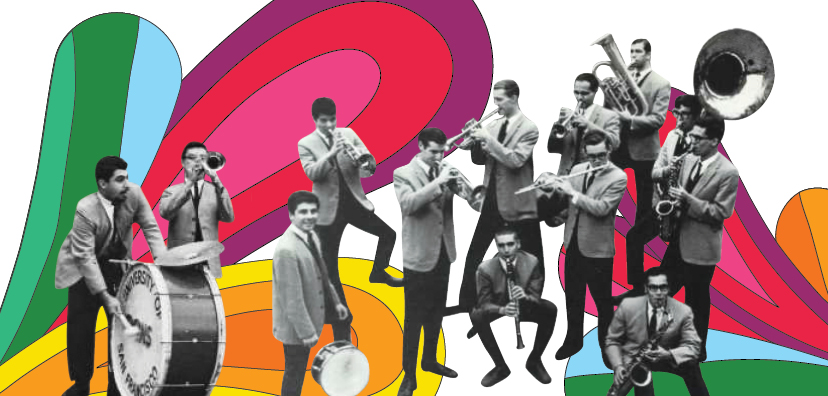
I was a button-down shirt and jeans guy. No tie-dye shirts. I kinda stood out. My family had traditional values.
For me, the San Francisco music scene was at the heart of the Summer of Love. I saw Santana, Jimi Hendrix, the Grateful Dead, and Jefferson Airplane at places like The Fillmore and Winterland Ballroom. My absolute favorite was Janis Joplin with Big Brother and the Holding Company. She had such a unique voice and style. I got to see them all when they were still opening for bigger acts.
Million-selling folkster
Jerry Burgan, organizational behavior ’87
I was a folk-singing freshman and guitar player at USF in 1963, along with fellow freshmen Bob Jones and Mike Stewart — whose brother, John Stewart, played banjo for the popular folk band The Kingston Trio. We left USF for Los Angeles to take a shot at making it in music in 1964. Our band, We Five, released its first single “You Were On My Mind” in 1965 and it became a million-selling hit and a precursor to the Summer of Love. I returned to USF around 1985 to finish my degree, while working in the pharmaceutical industry.
Jimi who?
Paul Farley, sociology ’71
I had a part-time job in the Haight delivering televisions. Jimi Hendrix lived across the street, Janis Joplin lived down the street, and the Grateful Dead lived around the corner. I would have paid closer attention had I known that period was going to be historic.
Officers and objectors
Tạm biệt (goodbye), Vietnam
John Tastor, history ’68
I was an ROTC guy. After graduation, I went into the Army for two years as an officer. I spent a year in Vietnam as an adviser to the Vietnamese. When I left, I always wondered what happened to them when the country fell.
About 25 years ago, I got involved in the affordable housing movement, helping to buy, develop, and manage quality housing for lower-income people. In 2015, San Francisco’s Habitat for Humanity contacted me and invited me to go with a group to Vietnam. I never expected to go back. I was able to connect with South Vietnamese veterans. They came around to talk whenever they found out I was an American veteran. Every time we would part, they would salute. It was such a great experience.
Marching orders
Michael Ahrens, political science ’67
During my time at USF, it was mandatory for male students to enroll in ROTC for two years. We dressed in old WWII uniforms and learned how to march on the baseball field carrying M-1 carbines. I never wanted to go into the military, but I liked the social fraternity of the ROTC called the Pershing Rifles. If a fellow in the fraternity saw new pledges on campus he could give them directions to do a lot of things like carry his books, go down for five push-ups, etc. They took all us new pledges to the beach at night once and buried us to our necks. We always had great parties at the Presidio Officers Club where, if you wore your uniform, they didn’t check IDs.
Me and my FBI file
Paul Vangelisti, English ’67
I was a conscientious objector. My sophomore year, I was called to see the dean. I remember telling him that I was not going to take ROTC anymore because it shouldn’t be compulsory. The dean asked if another person could come into the meeting, an FBI guy. Many years later I got my FBI file through a FOIA Freedom of Information Act] request, and sure enough all this was there — including one of my best friends who turned out to be an informant.
Those were very odd and heady times. At graduation, a bunch of us got up and turned our backs during “The Star Spangled Banner.”
Free love and politics
Rally for Reagan
Gary Anderegg, political science ’69
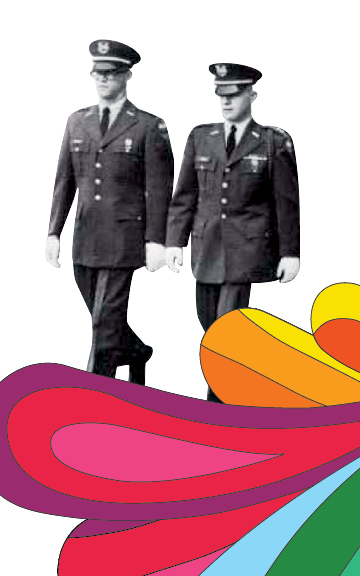
I was a Barry Goldwater Republican when I came to USF. I volunteered and worked for the Reagan-Finch for California governor campaign in 1966, with my buddy Rich Gosse ’70. We walked precincts to get out the vote and attended the victory party. My rebellion was to cast my first vote for Richard Nixon in 1968, although I’m a Democrat today.
I was USF junior class vice president and a member of the Philhistorian Debate Society, led by Fr. James Dempsey. As vice president, I was put in charge of designing the USF homecoming float, which we built on a rent-a-truck at one of the Embarcadero piers. We used chicken wire and covered it with paper flowers and named it “Flower Power.”
I used to go to Haight Street on Fridays to purchase the Berkeley Barb newspaper and read the news and personal ads. I put a personal ad in the paper once and got a call from someone who said she was Janis Joplin. She asked if I knew who she was.
“You are the singer with Jefferson Airplane?” I asked, not entirely sure. “I don’t believe you,” I said, and hung up.
To this day, I wonder if that was really Janis, as it sounds like something she would have done. Take a little piece of my heart now, baby!
Bring a hippie to class day
Judy Terracina, sociology ’68
I was a member of the first all-coed class. USF was pretty isolated from what was happening in the Haight, even though we were just a few blocks away.
I remember one of my theology teachers inviting a hippie to class so that we could interview him. He talked about being “free” and “liberated.” Other than the one who came to class, I mostly saw hippies in Golden Gate Park when I went there to study. I thought they dressed oddly, listened to weird music, and didn’t know how to dance.
I learned a lot from speakers who came to campus. Catholic theologian Michael Novak, co-author of the seminal anti-war book Vietnam: Crisis of Conscience, spoke on the quad.
Inspired by a Kennedy
Caitie O’Shea, history, Lone Mountain alumna ’67
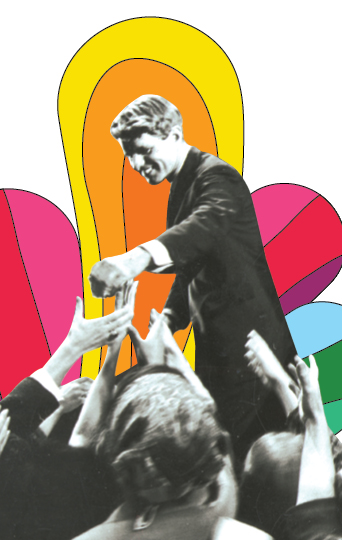
Women were in a different place then. There were a lot of ideas about what women were supposed to be doing, but things were starting to move in different directions. It was the ’60s! There were more options, and we were part of a growing conversation. The women at Lone Mountain were changing, and in many ways we were more radical than the men of USF because it was a time of awakening.
By 1967, my senior year, I was elected student body president of Lone Mountain College. As a freshman, I lived through the tragedy of John F. Kennedy’s assassination. That experience strengthened my determination to join the Peace Corps after graduation, and I ended up going to Malaysia. When Bobby Kennedy came to USF for an election rally in May 1967, I walked down the hill to USF to meet him and touch that part of history. I looked up to him — many of us did.
“Ask the first girl you see”
Jerold Di Regolo, psychology ’67
In spring 1967, I was the teaching assistant in a psychology lab for Professor Larry Murphy. I was enamored with a lovely coed and pursued her for more than a year. For her birthday, I bought her an expensive and very beautiful yellow dress from I. Magnin & Co. in Union Square. I wrapped it in a large white box with a wide red bow and left it for her, expecting to hear back.
A few days passed and no word. I was hurt.
I received a phone call from Professor Murphy. He asked me to come to his office. When I opened his office door, there was the big white box with the red ribbon. She didn’t want to hear from me again. Professor Murphy and I talked for 45 minutes. He was kind, gentle, and very understanding. His advice was simple: “When you leave this building, I want you to ask the first girl you see out on a date.”
Blindly obedient, I staggered out of Campion Hall (Kalmanovitz Hall today) and headed for my dorm. I saw Betty Blackburn walking toward me. She was a freshman psychology major enrolled in the other psychology lab. I immediately asked her out on a date. Two years later we were married.
A few weeks ago, my wife and I and my daughter and her husband visited USF. I showed my daughter the spot where 50 years ago I asked her mother out on our first date. For me, 1967 truly was the summer of love.
Cultural bubble
Professor Allan Cruse, mathematics 1966–2009
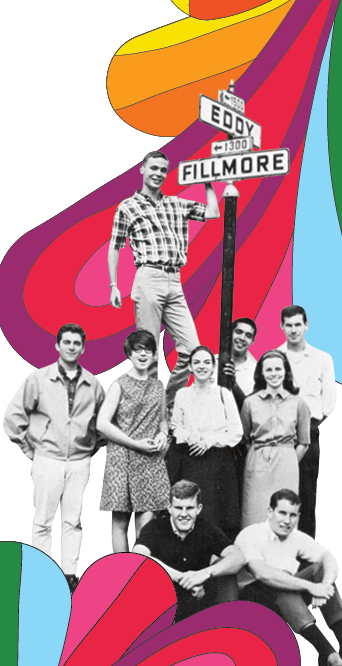
My office was on the second floor of Harney Science Center, where the men’s bathroom had a shower so that students could hose off in case of a chemistry lab accident. Young people in the Haight found out the building was unlocked at night and started taking advantage of the free showers.
I viewed the campus culture in those days as a kind of cultural bubble, conformist in dress and manners. Non-conformist counterculture views were regarded with suspicion, considered somehow subversive, and advisable to keep away from. If any faculty spent time in the Haight or participated in any happenings or protests, they seldom talked about it on campus. A notable exception was English Professor Patrick Smith, who began to wear multi-colored clothing on campus and express unorthodox ideas — proposing to invite “wandering scholars” to give seminars on art, poetry, and philosophies on how to reorganize society.
About the Author: Nicole Meldahl MA ’16 is a writer, historian, and museum professional in San Francisco. She’s contributed numerous articles to the California Historical Society’s website about the Summer of Love.
